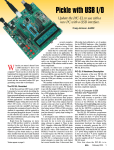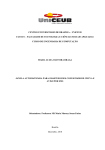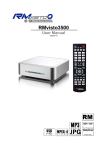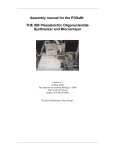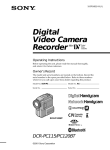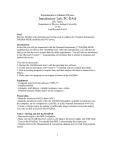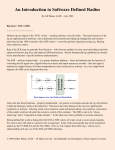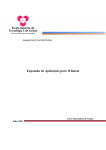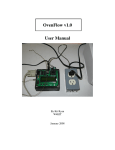Download Daughtercard User Manual (PDF format)
Transcript
AAØZZ Si570 Daughtercard and PIC Software A Signal Generator for 10 to 157 MHz By Craig Johnson, AAØZZ AAØ[email protected] www.cbjohn.com/AAØZZ TABLE OF CONTENTS Introduction ..............................................................................................................................................2 Hardware Description ...............................................................................................................................2 2.1 Circuit Description ...........................................................................................................................2 2.2 Daughtercard with PIC-EL Board ....................................................................................................3 2.3 Daughtercard In Stand-alone Board .................................................................................................3 3 Si570 Daughtercard Assembly .................................................................................................................3 3.1 Parts Identification............................................................................................................................3 3.2 Assembly ..........................................................................................................................................3 4 PEgen570 Software Application ..............................................................................................................4 4.1 A 16F88 PIC .....................................................................................................................................5 4.2 Band Tables ......................................................................................................................................5 4.3 Si570 Calibration ..............................................................................................................................6 4.4 User Interface ...................................................................................................................................6 4.5 Menu .................................................................................................................................................6 4.5.1 Sideband Selection .......................................................................................................................7 4.5.2 CW Sidetone During Receive ......................................................................................................7 4.5.3 Frequency Division for LCD Display ..........................................................................................7 4.5.4 FSK Frequency Shift ....................................................................................................................7 4.6 LCD Display .....................................................................................................................................8 Appendix A – Schematic ..................................................................................................................................9 Appendix B – Parts List .................................................................................................................................10 1 2 AA0ZZ Si570 Daughtercard v1.6 July 12, 2011 -1- Copyright 2011 AA0ZZ Appendix C – Si570 Daughtercard Parts Placement ......................................................................................11 Appendix D – Si570 Daughtercard PC Board ................................................................................................12 1 Introduction This Daughtercard uses the Silicon Labs Si570 DSPLL and software to generate RF signals in the continuous range of 10 to 157 MHz. Since many amateurs use divide-by-four mechanisms in Quadrature Sampling Detectors (QSD) – i.e, “Tayloe” mixers - for their receivers and also in Quadrature Sampling Exciters (QSE) for their transmitters, the Si570 Daughtercard can provide the local oscillator signal for receivers and transmitters which operate on the 80 through 10 meter amateur bands. 2 Hardware Description The Si570 DSPLL programmable frequency synthesizer is a relatively new technology developed by Silicon Labs. The Si570 offers some advantages over the DDS parts that have been used in applications in the past years. Two advantages are greatly reduced power consumption and the clean output without DDS byproducts (spurs). Silicon Labs offers several versions of the Si570 with different output options and frequency limits. The version used in the Daughtercard is a CMOS part with a 10.0 MHz default frequency and a 160 MHz maximum frequency. (The upper limit implemented in the PEgen570 application is 157 MHz.) The internal crystal of the Si570 runs at a nominal 114.28 MHz. However, the crystal in any individual part will not oscillate at exactly this nominal frequency. Since the the crystal frequency is used in the frequency parameter calculations in the software, the deviation from nominal means that the frequency the Si570 generates will not be accurate. Fortunately Silicon Labs calibrates each individual part and saves the parameters in its nonvolatile memory to cause it to start up at the default frequency (in this case, 10.0 MHz). The software can retrieve the parameters from the nonvolatile memory and calculate the calibrated crystal frequency. This actual crystal frequency can be used in subsequent calculations and the results will much more accurate than it would be if the nominal crystal frequency was used. The Daughtercard can be used in a platform of your choice but here are a couple of examples. 2.1 Circuit Description The schematic is shown in Appendix A. Since the PIC runs at 5v and the Si570 runs at 3.3v, signal level translation circuitry is necessary. Much of the circuitry on the board exists to do this translation. At first the problem seems trivial to solve but, since it must be bi-directional, it is not quite that easy. At first glance the circuit is quite elegant in its simplicity but when it is looked at closely it is a little more complicated. The design is not original to me but is described in many I2C specifications. The Daughtercard has two voltage regulators. One converts 12v to 5v and the other converts 5v to 3.3v. Why not just bring 5v from the PIC-EL? Two voltage regulators are used because the PIC-EL header is connected to 12v for the DDS-60 and I didn’t want to rewire the PIC-EL for the new Daughtercard. The Daughtercard has two RF output paths from the SI570 to the headers even though the CMOS version of the Si570 which we use for the Daughtercard only has one output (CLK+ on HDR3). The second RF path (CLK- on HDR4) is there in case a different version of the Si570 is used in the future. The CLK+ signal is also routed to the 8-pin connector (HDR1) so the PIC-EL’s RF jack is usable. AA0ZZ Si570 Daughtercard v1.6 July 12, 2011 -2- Copyright 2011 AA0ZZ Other versions of the Si570 have higher frequency limits but with reduced amplitude output. The spec sheet for the CMOS version says it operates between 10 to 160 MHz but some users report it can be used between 3.5 and 240 MHz. (The upper limit implemented in the PEgen570 application is 157 MHz.) Header HDR2 is a 2x2 connector block that is not used when the Daughtercard is used in a PIC-EL. However, when the Daughtercard is used in a different platform, two jumpers can be installed in this header block (1 to 2 and 3 to 4) to route the I2C communications through the 8-pin interface connector. This eliminates the need for the external wires from the stereo jack to the platform. 2.2 Daughtercard with PIC-EL Board One platform for the Daughtercard is the AAØZZ PIC-EL board. (The PIC-EL board is available from Kanga at www.kangaus.com . See details on my web page also.) An AAØZZ Signal Generator sample application for the PIC-EL is available so it is very convenient if you want to experiment with the software. The Si570 Daughtercard was designed to fit into a socket on the PIC-EL board that was originally designed to accommodate a DDS-30 or DDS-60 Daughtercard from AmQRP. The DDS Daughtercard operates with three control lines. The Si570 Daughtercard is simpler in that it operates with two communications lines. However, the communications scheme used by the S570 is I2C and that means the lines are both bidirectional. This presents a problem for the PIC-EL since two of the three PIC lines that go to the Daughtercard interface are also shared by the LCD and the other line is shared with the programmer. This sharing of pins prevents two-way communications via I2C with these lines. The workaround is to use an external cable to connect the daughtercard to the PIC-EL’s paddle jack. The paddle jack connects to different PIC pins and these pins are only shared with PIC-EL Pushbuttons 2 and 3. These two pushbuttons cannot be used when operating the Si570 daughtercard but otherwise the lines work well for I2C communications. 2.3 Daughtercard In Stand-alone Board See Control Board manual. 3 Si570 Daughtercard Assembly 3.1 Parts Identification The builder should first identify all the parts in the kit. The parts are listed and described in Appendix B. Every effort is made to include all parts in the kit; however, mistakes do happen. If you are missing a part, notify Bill Kelsey at Kanga and he will send the missing parts to you. It may be faster to get common components from your own “junk box” or at your local Radio Shack store. 3.2 Assembly The silk-screen part names on the board will be your guide. The order in which you place the parts is not critical but I would suggest that you install the MOSFETs last for static-protection reasons. Here is a possible assembly order that works well if you have a PIC-EL board. 1. Install the two voltage regulators, U1 and U2. Be sure you distinguish them properly and install them in the correct locations! 2. Install the resistors and the capacitors. 3. Install the header connectors HDR1 and HDR2. 4. Test the voltages coming out of the voltage regulators. AA0ZZ Si570 Daughtercard v1.6 July 12, 2011 -3- Copyright 2011 AA0ZZ a) Plug into PIC-EL board and power up. b) Use a Volt meter to check: o 12v coming into HDR1 pin 8. o 5v out of U1. Check at point where regulator connects to C3. o 3.3v out of U2. Check at point where regulator connects to C5. o IF ANY OF THESE VOLTAGES ARE NOT CORRECT, YOU MUST RESOLVE THE PROBLEM BEFORE PROCEDING! 5. Install the Si570. Be sure to align the “dot” on the Si570 with the “1” on the PCB. Center the Si570 on the pads and apply a small amount of solder to one pad and Si570 connection point. Then, before soldering the other connection points, check the alignment of all 8 connection points on the pads. Reheat and reposition the Si570 on the pads if necessary. Then solder the remaining 7 connection points. There three connection points on each side and one on each end. 6. Install MOSFETs Q1 and Q2. Orient per the silkscreen markings on the PCB. 7. Install the stereo phone jack, J1. 8. Construct the jumper assembly with 2 or 3 wires. One from tip-to-tip and the other from ring-toring. A ground connection wire is optional. 9. Plug Daughtercard into PIC-EL board. 10. (Optional) Software is not necessary for Si570 to generate RF at the Si570 default frequency of 10.0 MHz. If you have a frequency counter or a receiver that can tune to 10.0 MHz, power up the PICEL and verify that you have an RF output signal at 10.0 MHz. If not, stop here and find problem before installing the PIC. If you don’t have a PIC-EL board, apply 12 volts to HDR1 pin 8, ground to the HDR1 pin 5, and look for the 10.0 MHz output on HDR1 pin 6. 11. Plug one stereo plug of jumper cable into the J1 of Daughtercard and the other jumper cable stereo plug into the “Paddles” jack of the PIC-EL board (J3). 12. Put the 16F88 PIC in 18-pin PIC socket of PIC-EL. 13. Program the 16F88 per PIC-EL instruction manual. 14. Switch the PIC-EL board PGM <-> RUN switch to RUN. 15. If you are using the AAØZZ Si570 Signal Generator software you MUST REMOVE THE 12v POWER FROM THE PIC-EL BOARD AND THEN RESTORE THE POWER AGAIN! This is important since it reinitializes and restarts the PIC program after programming. NOTE THAT THE PIC-EL RESET BUTTON DOES NOT START THE PIC PROGRAM since the Signal Generator program configures the PIC to use the PIC-EL RESET button as a functioning pushbutton instead of as a PIC RESET. The Signal Generator needs this button since two of the other three pushbuttons co-opted for use by the I2C communications via the “Paddles” connection. 4 PEgen570 Software Application My sample application software for the AAØZZ Si570 Daughtercard is called PEgen570. It runs on a simple, inexpensive 16F88 PIC in the PIC-EL board. As explained in Section 2.2, the daughtercard uses an external cable to communicate with the PIC-EL board. AA0ZZ Si570 Daughtercard v1.6 July 12, 2011 -4- Copyright 2011 AA0ZZ 4.1 A 16F88 PIC There are several reasons why the 16F88 is used for this application instead of the PIC-EL standard 16F628A: 1) Compared to the 16F628A, the 16F88 has more than twice as much FLASH memory (for program instructions), 50% more data memory (for variable storage and tables) and twice as much EEPROM memory (non-volatile storage). 2) The 16F88 has an 8 MHz internal oscillator while the 16F628A has a 4 MHz internal oscillator. The extra speed is nice. 4.2 Band Tables The software is implemented to use 24 frequency bands. Most of the parameters that the Si570 requires to produce the desired output RF signal are in tables in program memory. The program memory tables cannot be modified with program instructions. These tables are used by the application with the band number as an index. One table is located in the PIC’s data memory and can be modified. This table is loaded from EEPROM upon power-up. This table consists of 24 entries with each entry containing a starting frequency requiring 4 bytes. This means that the 24-band table requires 96 bytes of memory. Since the maximum size of any single bank of data memory in the 16F88 (or any “16F” PIC for that matter) is 96 bytes. This determines the maximum number of bands that can easily be handled in the PIC. With additional overhead the size could be expanded and then the upper frequency could be increased. However, the CMOS version of the Si570 (the version that the Daughtercard is designed to use) has a maximum frequency of 160 MHz. This means the current 96-byte table with an upper limit of 157 MHz is sufficient for this Si570 version. The lower limit of the Si570 is 10 MHz and the 96-byte table also handles this limit. The 24 PEgen570 bands were created by examining the Si570 spec sheet and making calculations with a spreadsheet based on the Si570 parameter requirements. Without getting into the esoteric requirements of the Si570 frequency generating parameters and the formula involving several specific “multipliers”, the Si570 internal crystal frequency and the desired output frequency, the frequency range of each band was calculated. The table was generated in such a way that the major parameters for each band can be precalculated and retrieved from tables when changing frequency. This greatly minimizes the number of complex calculations that must be done for each frequency change. The 24 PEgen570 bands are defined as follows: BAND Frequency Range BAND Frequency Range BAND Frequency Range BAND Frequency Range 0 10 - 11 MHz 6 19 - 21 MHz 12 36 - 41 MHz 18 81 - 90 MHz 1 11 - 12 MHz 7 21 - 23 MHz 13 41 - 47 MHz 19 90 - 101 MHz 2 12 - 13 MHz 8 23 - 15 MHz 14 47 - 54 MHz 20 101 - 111 MHz 3 13 - 15 MHz 9 25 - 28 MHz 15 54 - 61 MHz 21 111 - 128 MHz AA0ZZ Si570 Daughtercard v1.6 July 12, 2011 -5- Copyright 2011 AA0ZZ 4 15 - 17 MHz 10 28 - 32 MHz 16 61 - 70 MHz 22 128 - 135 MHz 5 17 - 19 MHz 11 32 - 36 MHz 17 70 - 81 MHz 23 135 - 157 MHz 4.3 Si570 Calibration The PIC’s Si570 band tables described in Section 4.2 are pre-calculated with the nominal value for the Si570’s internal crystal frequency (114.285 MHz). The table entries, combining the crystal frequency with other parameters needed to generate RF in that frequency range, are stored in the PIC’s EEPROM and are loaded into the PIC’s volatile memory at power-up. This nominal frequency is almost never perfect, of course, but the Si570 is calibrated in the factory to use corrected parameter values to produce the default start-up output frequency of exactly 10.0 MHz. (Other Si570 part numbers use different start-up frequencies.) By holding Pushbutton 3 down during power-up, the application is directed to retrieve the parameters from the Si570’s non-volatile EEPROM memory. The software then does a “reverse calculation” to find the actual Si570 crystal frequency as determined by the factory to produce 10.0 MHz. After the actual crystal frequency is determined, the table entries are recalculated and copied back to non-volatile EEPROM. When Pushbutton 3 is released, the PIC restarts and populates the tables with the newly calculated values. 4.4 User Interface The user interface for the PEgen570 application is very simple. It uses two pushbuttons, an encoder, and a 2- line by 16-character LCD. The “Reset” pushbutton on the PIC-EL board is configured (via the CONFIG statement in the source code) such that it does not perform a microprocessor reset when pressed but to operate as a normal I/O pin instead. This made the pushbutton available for operation and it is needed. To clarify this change in usage, the pushbutton will be referred to as Pushbutton 4 rather than the Reset pushbutton. This means that the 9PIC-EL board must be powered down and up after loading new software into the PIC before the new program will start executing. Simply moving the slide switch from PGM position to RUN position does not start the program. The Pushbutton 3 and Pushbutton 4 are the two operational pushbuttons. When running the Si570, each time Pushbutton 3 is pressed and released the tuning digit that is currently being modified by turning the encoder to be increased by one digit. It can be advanced up to the 1 MHz position. Similarly, each time Pushbutton 4 is pressed and released, the tuning digit that is currently being modified by turning the encoder to be decreased by one digit. The digit that is currently being modified by the encoder is underlined. When the daughtercard is running, pressing and holding Pushbutton 3 for longer than 2 seconds stores the current frequency in EEPROM. This frequency is used as the start-up frequency on subsequent power-ups. 4.5 Menu A simple menu is used for changing 3 items in the operation. 1) Sideband selection 2) Frequency division for LCD display AA0ZZ Si570 Daughtercard v1.6 July 12, 2011 -6- Copyright 2011 AA0ZZ 3) FSK enable (if FSK is enabled via compile option in source code) The menu is activated by holding Pushbutton 4 while pushing Pushbutton 3 and then releasing them both. The current mode is shown in character position 1 of line 1 of the LCD. Now the user can update the current selection of each of the three items. Tapping Pushbutton 3 allows the user to cycle through the available options for the current item. Tapping Pushbutton 4 leaves the current item at its last value and advances to the next item in the menu. After the last item has been selected, pressing Pushbutton 4 exits the menu. 4.5.1 Sideband Selection The first menu item that may be selected in the menu is the sideband selection. The user may select one of four sideband modes, USB, LSB, CW+ or CW- . An external latching relay is engaged or disengaged as the sideband is changed in the menu. PIC output ports RA6 and RA7 attach to HDR5 and HDR6 (pins 15 and 16) respectively. As the sideband is changed in the menu, either RA6 or RA7 is driven high with an 8 mS pulse (with the opposite side being held low) to engage or disengage the external latching relay. The recommended latching relay (TQ2-L-5V – DigiKey part 255-1004-5-ND) requires 14 mA at 5v for 3 mS plus contact bounce time. The latching relay is intended to enable the proper I and Q phases of the transmitter and/or receiver to set the proper sideband. 4.5.2 CW Sidetone During Receive If the mode is CW+ or CW- , Header HDR7, attached to PIC input port PB7, is monitored by the software to determine whether or not to shift the frequency by the sidetone amount. HDR7 is expected to be set to a low state by external Transmit/Receive circuitry during Receive operations and to a high state during Transmit operations. The software continually monitors the signal at HDR7 and, when is detected to be low while in CW- mode, shifts the frequency down by 600 Hz from the nominal, displayed frequency. If the mode is CW+ and HDR7 is LOW (Receive), the frequency is shifted up by 600 Hz from the nominal, displayed frequency. In either case, whenever HDR7 is detected to be HIGH, indicating Transmit operation, the frequency will be set back to the nominal frequency that is displayed on the LCD. How fast does it switch? The software looks at the signal on HDR7 often enough to detect and change the frequency within 1.6 mS of HDR7 changing state. That’s fast enough for QSK. 4.5.3 Frequency Division for LCD Display The PEgen570 application can be configured to display the current Si570 generated frequency or it can be configured to display the Si570 frequency divided by two or four. The divide-by-four option is useful when the signal generator is being used as a signal source for a QSD/QSE (“Tayloe”) mixer. The circuitry for these mixers usually divides the input frequency by four so this software option allows the LCD to display the mixer’s operating frequency. Tapping PB3 while in this portion of the menu allows the divide-by-x factor to be changed. When the correct factor is selected, press PB4 to advance to the next menu item selection. 4.5.4 FSK Frequency Shift This menu item is only available and displayed only if the FSK option is enabled via a #DEFINE statement in the source code. The default software does not have FSK enabled. Tapping PB3 while in this portion of the menu allows the FSK option to be enabled or disabled. When the correct factor is selected, press PB4 to advance to the next menu item selection. AA0ZZ Si570 Daughtercard v1.6 July 12, 2011 -7- Copyright 2011 AA0ZZ If FSK is enabled, the FSK shift size will be used, even if CW+ or CW- is also selected in the menu. FSK takes precedence. When FSK is active, Header HDR7, attached to PIC input port PB7, is monitored by the software to determine whether or not to shift the frequency by the FSK shift size. The frequency is set to the displayed frequency when the signal on HDR7 is HIGH (the MARK frequency) and is shifted down by 170 Hz when the signal on HDR7 is LOW (the SPACE frequency). The software looks at the signal on HDR7 often enough to detect and change the frequency within 1.6 mS of HDR7 changing state. 4.6 LCD Display The first line of the LCD displays the current frequency. The second line is for debug purposes and shows the hex digits for the 6 Si570 register parameter (SiReg7 through SiReg12) starting at LCD position 1. The current band number is displayed in positions 15 and 16 of line 2. As explained in the Menu section regarding the frequency division selection option, the PEgen570 application can be configured to display the current Si570 frequency or it can be configured to display the Si570 frequency divided by two or four. The divide-by-four option is useful when the signal generator is being used as a signal source for a QSD/QSE (“Tayloe”) mixer. The circuitry for these mixers usually divides the input frequency by four so this software option allows the LCD to display the mixer’s operating frequency. AA0ZZ Si570 Daughtercard v1.6 July 12, 2011 -8- Copyright 2011 AA0ZZ Appendix A – Schematic AA0ZZ Si570 Daughtercard v1.6 July 12, 2011 -9- Copyright 2011 AA0ZZ Appendix B – Parts List Si570 Daughtercard Quantity Designator 1 HDR1 1 3 J1 for I2C cable C1, C4, C6, C8 C7 C2, C3, C5 R1-R4 U3 U1 U2 Q1, Q2 HDR2 for HDR2 for I2C cable 1 U1 2 4 1 3 4 1 1 1 2 1 2 1 Parts Description 8-pin RA Header Audio Jack 3.5mm Ver 1.3 Part number (Samtec) TSW-108-08-F-S-RA (D) CP1-3513N-ND (M) 161-3507-E 12/28/2010 Single Price $0.26 Total Price $0.26 $0.53 $0.53 $1.04 $2.08 Stereo plug 3.5mm Male (D) CP-3502-ND .1 uF ceramic cap .001 uF ceramic cap-axial 10 uF tantalum cap 1K resistor 1/8w 5% Si570 CMOS 20ppm 10MHz REG LDO 1A 5.0V SOT223-3 REG LDO 1A 3.3V SOT223-3 BS-170 N-chan MOSFET pin header, 0.1", 2x2 pos'n shunt, 0.1", 2 pos'n #22 Insulaed Hookup wire (3 colors, 7" each) (D) 478-4855-ND (D)1116PHCT-ND (D) 399-3638-ND (D) 1.0KEBK-ND Silicon Labs 570CBC000107DG (D) ZLDO1117G50DICT-ND (D) ZLDO1117G33DICT-ND (D) BS170-ND (M) 571-1032402 (D) S9000-ND $0.19 $0.08 $0.79 $0.06 $25.06 $0.62 $0.62 $0.48 $0.32 $0.08 $0.76 $0.08 $2.37 $0.23 $25.06 $0.62 $0.62 $0.96 $0.32 $0.16 (D) A3051B-100-ND or similar $0.10 $0.30 PIC 16F88 (programmed) (D) PIC16F88-I/P-ND with AA0ZZ software $7.50 $7.50 PCB AA0ZZ supplied $4.00 $4.00 ======== $45.85 AA0ZZ Si570 Daughtercard v1.6 July 12, 2011 - 10 - Copyright 2011 AA0ZZ Appendix C – Si570 Daughtercard Parts Placement AA0ZZ Si570 Daughtercard v1.6 July 12, 2011 - 11 - Copyright 2011 AA0ZZ Appendix D – Si570 Daughtercard PC Board AA0ZZ Si570 Daughtercard v1.6 July 12, 2011 - 12 - Copyright 2011 AA0ZZ












